June 16-19, 2010
Lynyard Cay marks the southernmost point in the Abacos that we will travel this year. It isn't known for much other than being across from Little Harbor, location of the most visited bar in this region, Pete's Pub. If there were waterway signage around here, like we see along the U.S. highways, a sign for Pete's would read “Last Chance to Get Wasted”. Every cruiser should go there at least once, just to see the laid back, casual, unique island bar, whose floor is beach sand, and visit the artist's gallery and foundry started by Pete's father. Eddie can tell you a good story about one of his late night adventures at Pete's on one of our former cruises.
This is one of my favorite anchorages in the southern part of the Abacos. The area is so sparsely populated, the ocean access is easy, the holding is good, the beaches are beautiful and peaceful, and the water is clear and cool with the ocean being so near. The opening picture was taken during a hike on Lynyard and shows the island to the west of us. You will really get the “picture” when you see the view from FLUKE in the following photos.
Notice that the ocean is visible (see the boat?). The land is very narrow in this section. See the beautiful beach. There is good shelling along this part of the island, but the most shells can be gotten at low tide down on the southern tip of the island, in the sandy areas that are on the western side of the rocks that jut out the end. It is best to snorkel the area and pick them off the bottom. The water is as clear as a bathtub's, so it is easy to see things. Eddie and I collected lots of “treasures” during our expedition. In contrast, here is what it looks like right on the other side of that beautiful beach. You wouldn't want to get washed up here!
The northern view is also pretty, having some taller trees, higher elevation, and some rocky outcroppings with even longer expanses of beachfront. A popular day beach, for the locals and tourists with rental boats, has a path from the west side over to the east where there is a pretty, sandy ocean side beach.
When we dropped the hook here at 5:30 p.m. on the 16th, the sun was beating directly into the cockpit, where we have a remote temperature sensor, and it read 119 degrees! We acted quickly to get up our “deflection” shield, a piece of screening fabric we hang up across the back of the boat to help keep the sun off the main salon when we are at anchor. Once we opened the boat and got the air blowing through everywhere things cooled down to around 98. Thankfully our refrigerator continued to hold its proper temperature, getting some relief from Donnie's last gas fix and the much cooler water we were floating in. Overall, we have had two weeks of great weather, but we know that can change quickly in these little islands.
The temperature also heats up when we work on our “chores”. We try to brainstorm to solve some of the problems, and we all have different ideas about how things should be done, so we raise our voices (if you know what I mean!) to try to promote our own points. W & E Marine Maintenance Inc. usually do a good job keeping up with making repairs, but they tend to slack off on the routine stuff. I have to give you an example.
I usually do all the vacuuming; it has to be done about once/week because of all the animal hair and how much sand we track in all the time. It takes 45-60 minutes to do a good job. Eddie is supposed to empty the vacuum and put it away. Well, the last time it was used, he didn't clean it out, but put it away anyway (that is not the first time for that either). I pulled out the vacuum (not knowing it was full) to use up in the pilothouse, and when I got to the top of the stairs, the front popped open. The filter, with all the hair and other debris fell out, missing the upper 3 steps, but hitting the other 5, knocking dust into the grooves in the steps and up the sides of the stairwell. It landed on the carpet at the bottom of the steps, and a huge cloud of dust rose up the stairwell, right into my face. It was just like something you would see in a cartoon! To say I was angry was an understatement, and it is a good thing we don't carry a gun aboard.
Making repairs on FLUKE is always made difficult by having to work in such confined spaces, whether it is above or below decks. Last year I wrote about our dinghy bilge pump becoming inoperable and that we had to hand pump the water all the time. Well, that problem just now got around to being fixed. It required removing the battery and practically crawling in under the seat to get to the bilge pump, fuse, and wiring that needed to be changed. People say the definition of cruising is working on the boat in exotic locations.
Eddie and Carol Audubon have diversified from their inwater activities to scour the island beaches for weathered pieces of wood so that we can make some bird nesting boxes to put up in our oak trees when we get back to Vero. We have lots of woodpeckers and screech owls in the neighborhood, and they will be able to make good use of some nesting boxes since there aren't enough tree holes to go around for all the birds who need them. Eddie even found a piece of wood with an entry hole already in it!
Like last year, we have seen nesting nighthawks and least terns. The nighthawk eggs are already hatching, and we have seen the little puffs of chicks. The least terns are just now laying eggs. On one of our wood hunts we were near a tern nesting area. They keep the “nests” above the high water mark, but well below the dune line of vegetation, where predators may more easily be found. It is important to watch where you walk so you don't step on the eggs. The terns were very agitated when I was taking these photos and were dive bombing and pooping on me to try to get me away from their nests. The first photo shows a typical nest, just a small depression in the sand with a little pile of shells or rock fragments.
This photo shows another type of nest arrangement. I wonder how the bird sits on this nest?
Maybe there was only room for one egg.
Here are two more eggs I spotted. The egg in the upper part of the photo is damaged (you can see a yellow spot on it and it had a fly on it), and I think it has been pushed away from the other one. However, the good egg doesn't even look like it is even in a nest, so maybe both eggs have been abandoned.
I'd be happy to stay here a while longer, but we need to move north and get closer to Marsh Harbor where we can try to buy some refrigerant in case the refer crashes again. I have a feeling that finding the gas and the fittings we need will be an island challenge for us.
Wednesday, June 23, 2010
Subscribe to:
Post Comments (Atom)
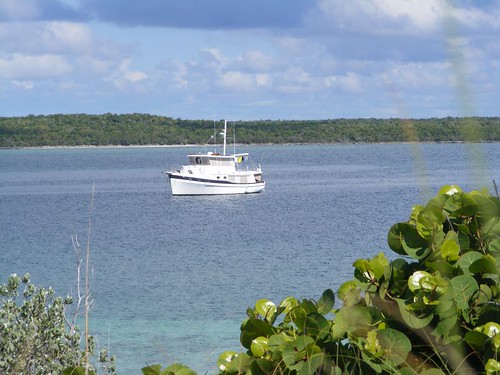
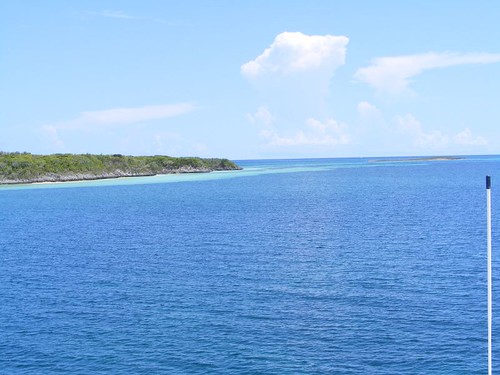
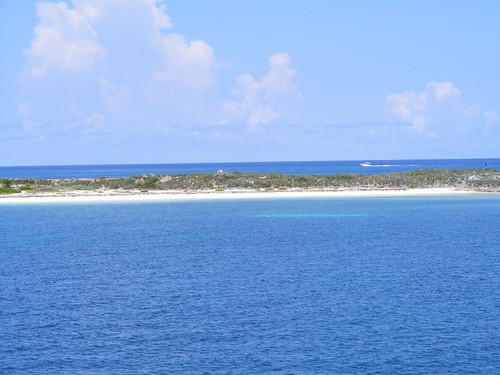
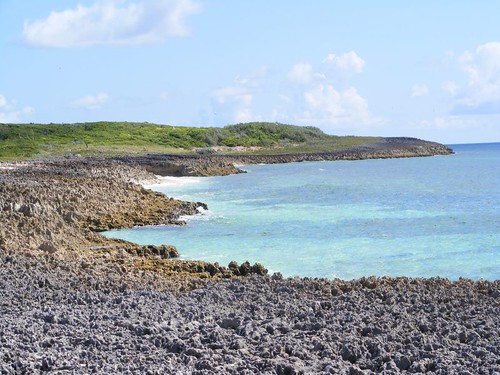

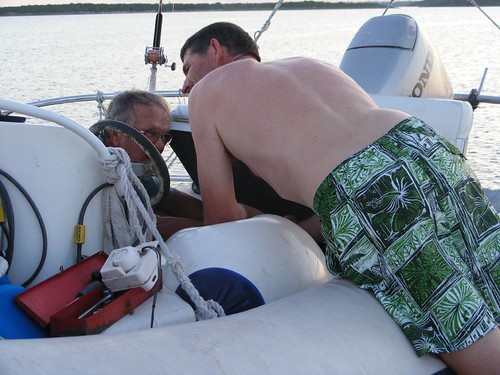
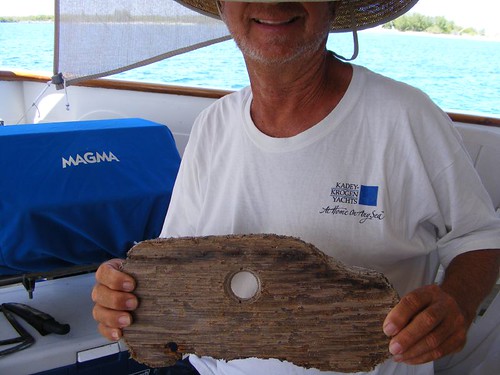
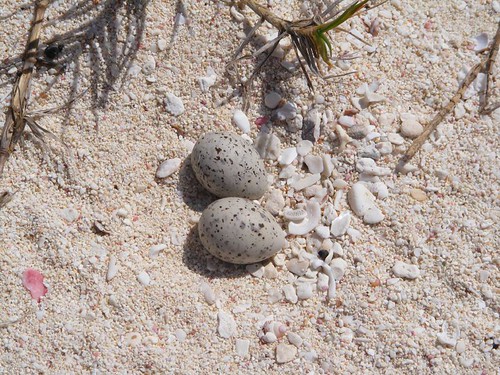
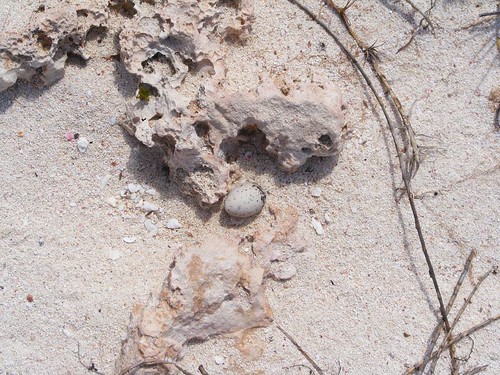
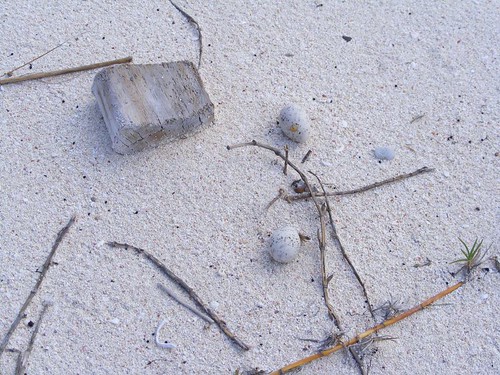








0 comments:
Post a Comment